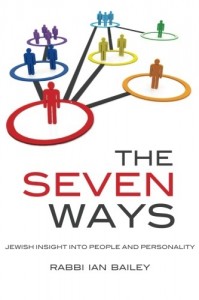by Rabbibailey | Sep 26, 2011 | Rabbi Bailey’s Blog
Help Me Answer a Question + A Sefirah a Day
The Toldot Yitzchak, a student of a student of a student of the famous Vilna Gaon (Gra), breaks down the 365 day solar year into two meaningful numbers: 343 and (more…)
by Rabbibailey | Sep 23, 2011 | Rabbi Bailey’s Blog
Nitzavim: Less is More; Anatomy of an Indulgence
For young Rabbi Shaya Kohn, dealing with drugs addicts and dropouts was a daily drama for over eight years. Kohn, who now helps young men earn GEDs at an alternative Jewish school, is a caring, energetic rabbi of medium hight and build, with a thick, bristly beard, and a perpetual smile spread wide on his face. When you meet him, R’ Kohn makes you (more…)
by Rabbibailey | Sep 14, 2011 | Rabbi Bailey’s Blog
Key Tavo: He Doesn’t Hate You, You Read It Wrong; When Assistance Is Met With Rudeness
Have you ever offered to help someone and they brushed you off or ignored you? Have you ever helped someone and they did not say (more…)
by Rabbibailey | Sep 9, 2011 | Rabbi Bailey’s Blog
The Biblical Connection:
Desire, Romance, and Attachment
Psychologists discuss the underlying psychological and biological (“biobehavioral”) ways in which we form intimate relationships. Once someone has found and spends time with the type of partner whom he or she prefers (correct temperament, mannerisms, background, etc.), that person is likely to develop fond feelings

for the partner and find his- or herself with what is plainly labeled by psychologists as (intimate) drive or desire for the other person. This is often coupled with or followed by what is called romantic love. The former is more deeply rooted in biology, but is connected to actions and thoughts, while the latter is something that may occur in such unhealthy ways as a quickly created obsession or, hopefully, grow healthily and naturally over time, as the couple spends time together and relates.
What is missing from this list is a third, well-known and intriguing biobehavioral system called attachment. When a couple initially connects, they may feel passionate feelings or the desire to connect physically, and these feelings can be healthy, proper feelings and lead to a healthy relationships and marriage, but they still are missing the healthy, true bond of attachment that is present in real relationships. This attachment is essential, because after this bond is created, the tone of the romance and desire components of the relationship are dictated by the quality of the relational bond of the couple (!). (All who want to work on themselves and their marriages will have more romance and love- it’s not something you can buy or order up!)
In their comprehensive work on psychological aspects of the family life cycle, McGoldrick, Carter and Garcia-Preto, (2011) discuss this bond, and explain that it is usually created after a year or two of a couple living together,  specifically when romantic love wanes to near non-existence. This observation by non-Jewish, clearly anti-(traditional) religious professors is, not coincidentally, the biobehavioral background for what Jews knew centuries ago: that “Shana Rishona” “The first year” that a couple spends together (based on Duet. 24:5) is crucial. Newlyweds spend down-to-earth quality time together during this year, with the husband not traveling or risking his life in war, so that the couple can form a healthy bond (after that, risk away!). This quality time has been demonstrated to be essential to healthy marriages by Dr. John Mordechai Gottman, who has penned his findings in practical advice and digestible content in The Seven Principles for Making Marriage Work (Gottman & Silver, 1999).
specifically when romantic love wanes to near non-existence. This observation by non-Jewish, clearly anti-(traditional) religious professors is, not coincidentally, the biobehavioral background for what Jews knew centuries ago: that “Shana Rishona” “The first year” that a couple spends together (based on Duet. 24:5) is crucial. Newlyweds spend down-to-earth quality time together during this year, with the husband not traveling or risking his life in war, so that the couple can form a healthy bond (after that, risk away!). This quality time has been demonstrated to be essential to healthy marriages by Dr. John Mordechai Gottman, who has penned his findings in practical advice and digestible content in The Seven Principles for Making Marriage Work (Gottman & Silver, 1999).
It is up to the couple to spend quality time together and rid themselves of unhealthy attachments, in order to properly connect.
“Therefore, a man will forsake his father and his mother and attach to his wife, and they will become one flesh.”
(Gen. 2:24)
This sentence, which many of us have heard and read on numerous occasions, has much significance, when understood in the light of Jewish tradition and contemporary psychological theory. As highlighted by the bolded letters, the sentence does not read ‘a man will have left’ ‘ne’ezav’ in the passive, but ‘will forsake’. The sentence is saying it as an imperative for, not a description of, a man to forsake the unhealthy attachments from his youth, in order to actively form the bond with his wife. (More on this in Parashat Lech-Lecha, which will be based on a workshop that I give entitled “Leaving Charan”).
Anyone who is married can attest to the fact that these attachments are what couples deal with for some time, especially at the beginning of marriage (Why do you need your food so badly? Why do you speak with your mother so often, it hurts our relationship? We need the money, why can’t I take this new job and move away from your family? We need to be independent). Also, new attachments are what each spouse picks up on in their partner and naturally rejects (Honey, you just quit smoking but replaced it with drinking caffeine. Is everything ok, since we moved away from your sister, you call me very often, when I am at work?).
The Biblical Roots
There is a very interesting law that a Jewish soldier is allowed to take a women from a non-Jews enemy nation and perform a conversion process on her and marry her (Deut. 21:10-14). During her conversion process, he must have her look disheveled and mourn her former family. After a man marries such a woman, he may he may end up staying married to her, or if he finds himself
“…not desiring her, he can send her ‘self’ [lenafsha] away…”
Scripture heralds that [his] destiny is to hate her.
(Deut. 21:24, with Rashi)
The Torah and Rashi are explaining that when a man is compelled to send away a woman such as this, that his attachment to her was solely to her appearance. Lenafsha is an extra word here; it means her ‘self’ in a very deep way. It is the same word as soul, and is used to describe life (as in the story of Creation). In conjunction, the Torah did not use a more common word for desire ratza ‘to want something’, but chafetz,  which has the connotation more of desiring an object (which is why the noun c’hefetz’ means ‘object’). He is essentially sending away an object that he was attached to, not the woman that she truly is.(1)
which has the connotation more of desiring an object (which is why the noun c’hefetz’ means ‘object’). He is essentially sending away an object that he was attached to, not the woman that she truly is.(1)
This soldier doesn’t really like her inner self, her true essence as a person. This section of the Torah, as has been said, is attempting to drive this woman away from the man, because, for some reason that needs explanation, our sages say that soldiers cannot help but desire these types of women during battle, and the Torah, consequently, made a mechanism to attempt to remove her from his life (Rashi, Talmud Kiddushin). With our understanding of attachment, this mechanism works quite well. It will dissolve this man’s attachment to her, through making her do these mournful actions and removing romantic love and desire; the couple has no real attachment, and, if they do, they will stay married (King David has many such wives, so I cannot fully disparage the idea). The analogy to relationships in life’s everyday interactions is clear. As with Amnon and Tamar, looks alone are not what form a healthy connection; they create but a romantic obsession.
[Order The Seven Ways! today! Now only $14.95 and $2.99 eBook]
May we all detach from unhealthy attachments and create healthy attachments with healthy people and constructive concepts.
IB
(1) Rashi sounds like he is saying that every person who does this will hate the woman. He may mean this quite literally: that anyone who actually succeeds in marrying her totally changed his attachment to the woman, but always ran the risk of hating or did hate her.
Bibliography
McGoldrick, M., Carter, B., and Garcia-Preto, N., (2011). The Family Life Cycle: Individual, Family, and Social Perspectives . Boston: Allyn and Bacon
Gottman, J., Silver, N. (1999). The Seven Principles for Making Marriage Work. New York: Crown Publishers.
by Rabbibailey | Sep 2, 2011 | Rabbi Bailey’s Blog
“When you come to the land that Hashem your G-d is
giving to you … you must place a king upon yourselves …”
(Deut. 17:14)
Good malchut has been robbed from us. By good malchut I mean (more…)
by Rabbibailey | Aug 29, 2011 | Rabbi Bailey’s Blog
The eBook version of The Seven Ways is now here!
Just click here to explore.
Compatible with all major eReaders.
Did you know that you can download an eReader onto your computer from Kindle for free?
Rabbi B
by Rabbibailey | Aug 25, 2011 | Rabbi Bailey’s Blog
Why We Keep Kosher
When we read about a mitzvah in the Torah, our contemporary brains usually conjure up a spiritual, behavioral/psychological, or sociological reason for the commandment. It is easy to explain that certain seemingly obscure (more…)
by Rabbibailey | Aug 22, 2011 | Rabbi Bailey’s Blog
Along with a team of wise women, I am composing a Seven Ways book specifically for women. The book will relate the seven different personalities to the unique experience of women and highlight their unique struggles and paths to victory through the stories of seven great women of the Torah (Bible).
As such, I am compiling letters and monologues from women who have been inspired and positively impacted by the Seven Ways system. They will be published (with permission) on this website and in the new book.
Please send your writings and ideas for a title to Rabbi Bailey at Questions (General). They are always treated as confidential until expressed consent is given.
Current title suggestions include:
The Seven Ways: Women’s Ways
The Seven Prophetesses
The Seven Women
Please send in your feedback!
by Rabbibailey | Aug 19, 2011 | Rabbi Bailey’s Blog
How do Your Parents Relate to God?
A Beautiful Binary
I’ve found that people generally conceive of their relationship with G-d as the same as the relationship that they had with (more…)
by Rabbibailey | Aug 12, 2011 | Rabbi Bailey’s Blog
Parsha Print-Me
Va’etchanan
There is a very common tension that is found in religious groups, organizations, and even marriages that appears in many forms, but inevitably has the same subtle subtext underneath. It is essential for one to be aware of this tension, as we spend a great deal of time dealing with it.
When a business or non-profit initially (more…)
by Rabbibailey | Aug 5, 2011 | Rabbi Bailey’s Blog
When you study the Torah, you inevitably find sources for insightful ideas or studies that have been gathered by human investigation and research. This is most notably true of psychological concepts. In this week’s Torah portion, Moshe (Moses) brings (more…)
by Rabbibailey | Aug 4, 2011 | Rabbi Bailey’s Blog
In this post I discuss: Secrets of the book: I included hidden nuggets of information within the interviews; also, how you can positively impact yourself tremendously from the book.
I realized that there are several different ways to read The Seven Ways that (1) people find most beneficial and (2) (more…)



